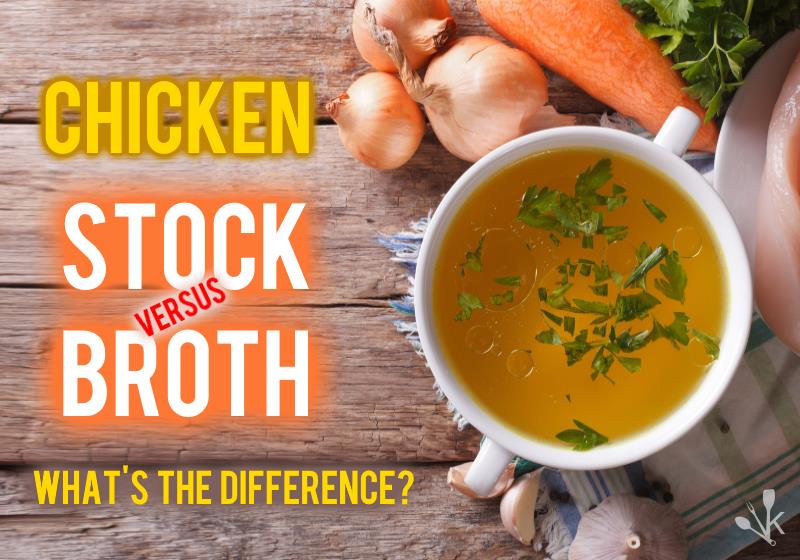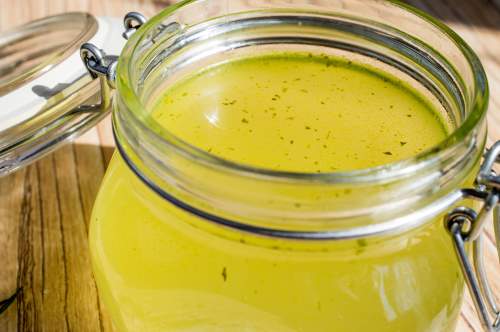White chicken is a great source of low fat protein. However, many people don’t care for the dark meat. This can mean leftovers that sit in the fridge until spoiled.
What to do with leftover chicken? Create an ingredient from it that you can use with other dishes. In this guide you will learn the difference between stock, broth, base and bouillon, recipes and ways to use them.

If you find a great sale on whole chicken, you can use the breast meat for one meal and cook down the rest of the bird and bones into stock or base. You can also cook a whole chicken for stock, then cool and debone the bird for chicken salad or a protein boost to a green salad.
Chicken Stock vs Broth
What Is the Difference Between Chicken Stock and Chicken Broth?

While stock and broth can often have the same ingredients, including carrots, celery, garlic, and a bay leaf, broth is made with just the meat and stock recipes generally include bones.
What is clear chicken broth? Simply a broth that has had all the veggies and meat strained from it.
Broth can be served as a soup as it has a heartier flavor, but stock is a base ingredient in many recipes. You can use the products interchangeably; just note that stock is generally not considered a final product at the table.
What is chicken stock? Stock contains bones during the cooking process. Stock is a great way to gather every bit of meat off of a whole bird.
If you’ve prepared a roast chicken and now have lots of bone left with plenty of shredded meat left on it, get out your biggest pot and make some stock.
Related | Le Creuset vs Staub
If your biggest pot won’t hold a chicken skeleton, get out your kitchen shears and cut the rib cage in half. Don’t cut too small; you want to fish the bones out of the pot when the stock is cooked.
Uses For Chicken Broth & Stock
Chicken stock and broth are both a great base for soups of many cultures. You can also prepare rice or other grains in chicken stock rather than water.
Thick egg noodles cooked in stock or broth make a great base for a casserole, and stuffing made with stock is a lush treat.
Related | Best Pasta Machines
Finally, a steaming bowl of homemade ramen in homemade chicken broth with a serving of sautéed vegetables on top is an ideal winter treat.
How To Make Chicken Stock & Broth
Stock is one of the most popular dishes among thrifty cooks. The chance to not only get all the chicken off the carcass but also extract the flavor from the bones make stock fun to prepare and a matter of pride to store for later use.
If you find a good deal on whole chickens, including giblets, food authority Susan Branch offers a rather intense but absolutely delicious chicken stock recipe.
Follow your thrifty urges and use all the giblets except the liver in your stock as well.
Please note that if you are planning to make chicken base, you don’t want to use the neck; the bones can be hard to find remove after intense cooking, and the liver will make your stock bitter.
- Brown your giblets in olive oil until they’re fully crispy, then add water to the pot to deglaze.
- Layer vegetables, peppercorns and bay leaves over the giblets, then place a whole chicken over the vegetables.
- Avoid adding salt at this time. You can add salt later once the chicken flavor has been abstracted.
The instructions for this recipe are fairly simple, but the whole process will take about seven hours.
Other recipes are a bit quicker, but be certain to get the chicken up to 170 degrees Fahrenheit / 77 degree Celsius for safe stock.
Chicken Broth Substitutes
In a pinch, you can use bouillon or a small spoonful of chicken base in your soup.
It’s important to remember that chicken stock is very versatile in terms of storage options.
How long does chicken broth last? You can freeze it in an ice cube tray if you just need a bit of stock or in one cup containers. As long as you keep it airtight, it will last for up to three months in the freezer.
Is Chicken Stock Healthy?
Chicken stock needs to be chilled after it cooks so the fat cools at the top so you can remove it.
It offers a much greater depth of flavor than bouillon and is easy to cool and store.
You get to enjoy the full complement of nutrients that were stored in the vegetables and the remaining protein from the chicken carcass.
A Word About Bay Leaves

For those who make stock with bay leaves, please note that you never want to leave bay leaves in your stock or prepare stock and then blend it once it’s cooked.
Their flavor is bitter and the leaf itself is tough and woody. For safety’s sake, it’s a good idea to count the bay leaves going in and make sure you take the same number out.
Related | What Is A Sprig
Many of us were warned that bay leaves are poisonous. Actually, the bay leaves you can buy from the store, those picked from the Laurel nobilis tree, are the only leaves from the laurel family that are not poisonous.
However, as experts with LiveStrong warn us, bay leaves taste awful and are hard to chew.
Chicken Base
What is Chicken Base?
Chicken base is the strongly condensed chicken stock. While stock works great for soup, chicken base is a great addition to stews, casseroles and gravies.
Chicken base is concentrated; it’s a paste, so it will need to be stretched with other liquids if you plan to use it for soup.
While chicken stock is the clear broth that remains from chicken meat or bones and vegetables, chicken base owes some of its thickness to the fact that everything but the chicken bones stays in the base. The vegetables and fragments of chicken are pureed by pressing the thick liquid through cheesecloth.
Uses For Chicken Base
Cooking expert Stephanie Manley recommends using chicken base when possible for the flavor intensity and flexibility. Because the vegetables and bits of chicken are not strained out, the flavor will intensify over time.
Chicken base paste is often for sale and displayed right next to the bouillon cubes. Once you open a jar of chicken base it will need to be refrigerated.
Store bought chicken base has a longer refrigerator life than homemade chicken base. Due to the time commitment of making chicken base, you may want to stick with the store bought.
How To Prepare Chicken Base
You can prepare your own chicken base, but be prepared to spend a lot of time next to your stock pot.
Use your favorite chicken stock recipe to start. Then it’s time to start simmering your stock down into chicken base.
Successful chicken base has to be reduced until 1/3 of the liquid you started with is gone, and this can take hours.
While your stock is reducing you need to be close by to stir the ingredients occasionally so the ingredients of the stock don’t scorch or stick to the pot. If you’re ever snowed in on a very cold day, this is an excellent project.
After the liquid level in the pot has been reduced by 1/3, you need to pull out the whole chicken and let it cool for a time. Once you can touch it safely, remove and discard the skin. Remove the cooked chicken from the bone, shred it and return it to the pot.
Substitute For Chicken Base
While a hearty stock will serve as a chicken base replacement, it will be a liquid rather than a concentrate and will not have the flavor intensity of chicken base.
Consider supplementing the recipe with seasonings commonly used in chicken stock, such as Spanish onions, garlic, salt, pepper and a bay leaf.
In a pinch, bouillon cubes or granules can be used. It’s important to remember that the flavor of chicken in bouillon cubes is generally secondary to the main ingredient, which is usually salt.
Consider improving the intensity of your bouillon flavor with other flavorful and chicken-friendly additions, such as celery leaves or minced onions for an aromatic improvement to your bouillon cubes.
Is Chicken Base Healthy?
Homemade chicken base is made with the skin on so once everything is cooked down it will have a higher fat content.
However, once your chicken base has cooled, the fat will float to the top. It can then be removed before sealing up your chicken base for up to three months.
Of course, it will still contain some fat, so it’s a good idea to seal the jar carefully to avoid picking up flavor from the refrigerator.
Chicken Bouillon
What Is Chicken Bouillon?

Chicken bouillon is a dehydrated version of chicken stock that is sold in instant granules or in cubes the will yield one cup of stock per cube of bouillon.
While this is a useful product to keep around for when you get in a pinch, it’s important to remember that bouillon can be very high in sodium and may not add much chicken flavor to your dishes.
Is chicken bouillon the same as chicken broth? No, it lacks the depth of flavor. However, it will do in a pinch.
There are several varieties of chicken bouillon, including a product called chicken powder, which is instant bouillon. It dissolves immediately in hot water and will serve to boost the flavor of any chicken dish or soup.
Uses For Chicken Bouillon
Cubed and powdered bouillon can be used to season soups and stews. They will break down in a crockpot over time, so if you’re starting a pot of soup in the morning, you might skip adding salt and add bouillon instead; it will increase the depth of flavor.
Cubed bouillon can also be used when preparing rice or another grain that has be added to boiling water. If you’re planning to prepare a grain like couscous that finishes off the burner, boil the water until the bouillon cube is dissolved.
If you’re hoping to make a gravy or cream of chicken stew, the powdered bouillon is a better bet. It doesn’t need to be boiled and will dissolve as your gravy thickens or as your creamy stew finishes.
How To Make Chicken Bouillon
To boil up a cup of bouillon, just remember that the bouillon cube to water ratio is one cup of water to one cube of bouillon. You will need to boil the water for a few minutes until the cube dissolves.
How much bouillon powder equals a cube? One teaspoon of granules equals one cube of bouillon.
The majority of homemade “chicken” powder or bouillon recipes have no chicken in them.
One of the most intriguing recipes is offered by. This “chicken” bouillon recipe is based on nutritional yeast flakes and many other spices, including smoked paprika. This is an excellent low sodium alternative for chicken bouillon crystals or cubes.
This bouillon powder replacement will keep for up to six months if stored in an airtight container. It’s quick to prepare and offers a much deeper flavor combination than can be found in regular bouillon products.
Substitutes For Chicken Bouillon
A simple stock is really the best substitute for chicken bouillon unless you plan to prepare a powder as listed above. The next section of this article offers several options for preparing your own stock.
If you have a crockpot, food expert Emma Christensen with TheKitchn.com offers a great recipe that you can slow cook all day using a leftover chicken carcass and some vegetables.
Is Chicken Bouillon Healthy?
Regular chicken bouillon is loaded with salt and low sodium chicken bouillon is rather dull.
Whip up a batch of the powder replacement noted above or pull out the crockpot and fix some stock. You’ll enjoy a healthier broth with better flavor.
Final Thoughts
For cooks who look forward to soup season all year, making stock is fun and a great way to clean out the bottom of the veggie drawer, as well as putting a chicken carcass to good use. You can use whole chicken for stock or the bones of a former meal.
Just make sure to clean up before and after with warm soapy water and boil your chicken until it reaches a safe internal temperature of 170 degrees Fahrenheit / 77 degrees Celsius.











